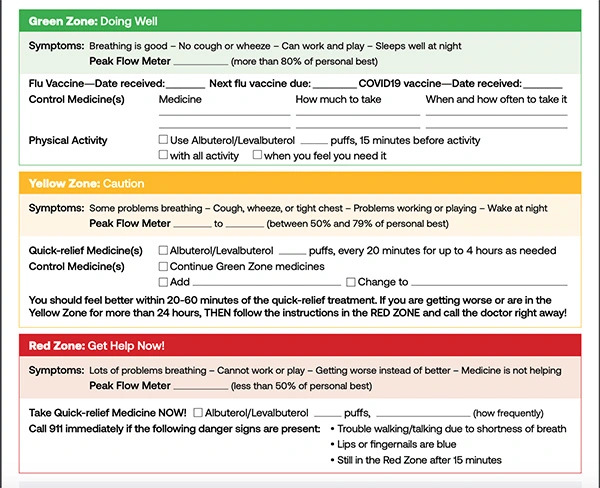Anyone who has been diagnosed with asthma, whether severe or mild, is encouraged to create a plan in case symptoms flare up. Having such a plan can help people with asthma and their loved ones manage symptoms daily and maybe prevent a visit to the doctor or emergency room. Traci Gonzales, a pediatric nurse at Texas Children’s Hospital, spoke with us about why everyone needs a plan and how to create one.
Q: Who needs an Asthma Action Plan?
I recommend an asthma action plan to all my patients.
For children, a plan is particularly important because they often don't treat their own symptoms, it's a caregiver who helps. So having copies of a plan for parents, grandparents, daycare workers and teachers, whoever is caring for the child, is essential. That way everyone knows the steps to take if that child’s symptoms start acting up. As younger children grow up, they can start to understand a bit more and use the plan on their own. It's a great tool for them to follow because we write it in simple verbiage that is appropriate for their age.
The plan is good for adults too, especially those who have intermittent asthma, and may only suffer symptoms a few times a year. They may not remember emergency steps and dosages if they are not taking medication every day, so it's good to have that plan just to ensure they are using the right inhaler and taking the steps to stay out of the ER.
Q: What are the steps for creating an Asthma Action Plan?
The key to a good asthma action plan is being easy to understand and use. We want to create something that, in the time of an emergency, a family member or a patient can look at and know exactly what part of the plan they need to go to and what medication they need to take.
All plans are divided into green, yellow and red zones. Typically, I sit with the patient and their family, and we fill in the zones together. I would encourage all patients to do this with their healthcare provider.
Asthma Action Plan Zones
Green Zone: No asthma symptoms. List of routine management medication and information. Not everyone has daily meds but if they do they go here.
Yellow Zone: Signs of worsening asthma symptoms, like an increase in coughing or shortness of breath. List of tips for self-management, including name of meds, color of rescue inhaler and dosage information.
Red Zone: Experiencing severe asthma symptoms that are not being helped with medication. Include emergency contact and medication information.
It’s important to write out the actual medication and the dosage in all zones because many times I'll use the same medication for the yellow zone and the red zones, just a higher dose as symptoms worsen. I also include how the medication is delivered. This is especially helpful for daycare or school workers, or anyone who doesn’t deal with asthma management daily. They will need to know if the person with asthma needs a nebulizer versus an inhaler with a spacer or a spacer with a mask.
Additionally, if the person with asthma isn’t using medication frequently, it's really important to check expiration dates, because medications may expire before they get used and you don’t want to find out you don’t have what you need in the middle of an asthma episode. You will also want to note where the medication is located so that you can always find it.
Q: How can plans differ?
Triggers will be different for every person with asthma and may change over time. For example, some people will have an increase in symptoms when tree or grass pollen is high. We see ragweed or different weeds here in the South. Since it's always warm, we have a long allergy season so we may still have high pollen counts in the middle of winter. Other than seasonal, many people with asthma may have indoor allergens that should be noted on their plan.
Plans will also differ in language based on age. For instance, I may include pictures and pain faces for little kids, which I think that helps them understand and identify their own emotions.
Q: Last-minute words of wisdom?
Be prepared, know your triggers and try to anticipate when the symptoms might go up and start management early. Make sure any caregiver can also recognize symptoms so that they can assist with treatment. As soon as those first symptoms are identified, start management. Don't wait. And the other thing is to really work closely with your healthcare provider because asthma, it's a team sport.
Blog last updated: October 24, 2025



